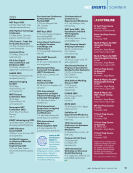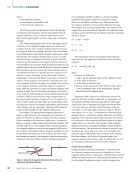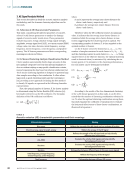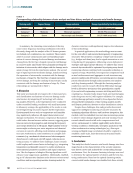BUILDING A FUTURE-READY NDT WORKFORCE:
INSIGHTS FROM THE ASNT FOUNDATION
As the nondestructive testing (NDT)
field continues to grow and adapt to new
technologies and industry demands,
understanding workforce dynamics is
essential. Recently, the ASNT Foundation
published valuable insights through
two exclusive industry reports: the 2024
Industry Workforce Readiness Report
and the 2024 Industry Compensation
Report. These findings are crucial for
employers, practitioners, and industry
stakeholders committed to cultivating a
skilled and satisfied workforce.
The Workforce Readiness Study
The aim of the 2024 Industry Workforce
Readiness Report was to assess critical
skills, identify skill gaps, and understand
workforce needs from the perspective of
both practitioners and hiring managers.
This comprehensive approach provides
a balanced view of readiness in the
field, along with insights into skill areas
that require further development. The
findings of the report were established
in four phases: in-depth interviews with
select stakeholders, electronic surveys,
stakeholder focus groups, and data
analysis. The findings are divided into
the following sections: the most critical
skills as rated by technicians, technicians’
assessments of their own skill levels, and
comparisons of those same critical skills
by hiring managers and recruiters.
Practitioner Perceptions and Skill
Development
One of the most valuable components
of the study was the self-assessment by
NDT practitioners. Practitioners rated
their own competency across various
skills deemed essential for the field, as
shown in Figure 1. This self-reflective
process highlighted areas where many
practitioners feel confident, as well as
areas that need improvement, such as
advanced data analysis and understand-
ing of cutting-edge NDT technologies.
Hiring managers and recruiters then
provided a comparative assessment of
these same skills, often noting disparities
between the skills practitioners felt com-
petent in and those that managers found
critical. This gap illustrates the need for
ongoing professional development and
targeted training programs to bridge
expectations between practitioners and
employers.
Hiring Challenges in NDT
In recent years, the NDT industry has
faced hiring challenges that reflect
broader trends in the technical and
engineering workforce (Figure 2). These
challenges include a shortage of qual-
ified candidates, high turnover, and an
increased need for specialized skills in
emerging NDT methods. The report
emphasizes that while experienced can-
didates are in demand, retaining talent
can be difficult due to perceived gaps in
compensation, career growth opportuni-
ties, and work-life balance.
This data emphasizes the impor-
tance of retention strategies, includ-
ing fair compensation, clear career
pathways, and support for work-life
balance. Implementing these strategies
could help companies attract and retain
top talent while meeting the evolving
demands of the NDT industry.
NDT Compensation Report
The 2024 Industry Compensation
Report provides a transparent look into
current salaries, benefits, and percep-
tions of compensation fairness. With
an average salary of US$127 821, the
report sheds light on the monetary and
FEATURE
|
NDTWORKFORCE
Figure 1. The most critical
skills needed for NDT
technicians, as identified
by survey respondents.
Figure 2. Most employers said it is very
challenging or moderately challenging to
fill open positions.
26
M AT E R I A L S E V A L U AT I O N • M AY 2 0 2 5
INSIGHTS FROM THE ASNT FOUNDATION
As the nondestructive testing (NDT)
field continues to grow and adapt to new
technologies and industry demands,
understanding workforce dynamics is
essential. Recently, the ASNT Foundation
published valuable insights through
two exclusive industry reports: the 2024
Industry Workforce Readiness Report
and the 2024 Industry Compensation
Report. These findings are crucial for
employers, practitioners, and industry
stakeholders committed to cultivating a
skilled and satisfied workforce.
The Workforce Readiness Study
The aim of the 2024 Industry Workforce
Readiness Report was to assess critical
skills, identify skill gaps, and understand
workforce needs from the perspective of
both practitioners and hiring managers.
This comprehensive approach provides
a balanced view of readiness in the
field, along with insights into skill areas
that require further development. The
findings of the report were established
in four phases: in-depth interviews with
select stakeholders, electronic surveys,
stakeholder focus groups, and data
analysis. The findings are divided into
the following sections: the most critical
skills as rated by technicians, technicians’
assessments of their own skill levels, and
comparisons of those same critical skills
by hiring managers and recruiters.
Practitioner Perceptions and Skill
Development
One of the most valuable components
of the study was the self-assessment by
NDT practitioners. Practitioners rated
their own competency across various
skills deemed essential for the field, as
shown in Figure 1. This self-reflective
process highlighted areas where many
practitioners feel confident, as well as
areas that need improvement, such as
advanced data analysis and understand-
ing of cutting-edge NDT technologies.
Hiring managers and recruiters then
provided a comparative assessment of
these same skills, often noting disparities
between the skills practitioners felt com-
petent in and those that managers found
critical. This gap illustrates the need for
ongoing professional development and
targeted training programs to bridge
expectations between practitioners and
employers.
Hiring Challenges in NDT
In recent years, the NDT industry has
faced hiring challenges that reflect
broader trends in the technical and
engineering workforce (Figure 2). These
challenges include a shortage of qual-
ified candidates, high turnover, and an
increased need for specialized skills in
emerging NDT methods. The report
emphasizes that while experienced can-
didates are in demand, retaining talent
can be difficult due to perceived gaps in
compensation, career growth opportuni-
ties, and work-life balance.
This data emphasizes the impor-
tance of retention strategies, includ-
ing fair compensation, clear career
pathways, and support for work-life
balance. Implementing these strategies
could help companies attract and retain
top talent while meeting the evolving
demands of the NDT industry.
NDT Compensation Report
The 2024 Industry Compensation
Report provides a transparent look into
current salaries, benefits, and percep-
tions of compensation fairness. With
an average salary of US$127 821, the
report sheds light on the monetary and
FEATURE
|
NDTWORKFORCE
Figure 1. The most critical
skills needed for NDT
technicians, as identified
by survey respondents.
Figure 2. Most employers said it is very
challenging or moderately challenging to
fill open positions.
26
M AT E R I A L S E V A L U AT I O N • M AY 2 0 2 5













































































